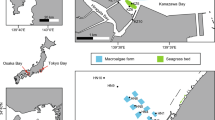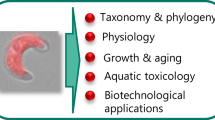Abstract
We examined how TiO2 nanoparticles (nTiO2) impact the growth and metabolism of three species of freshwater green algae (Scenedesmus quadricauda, Chlamydomonas moewusii, and Chlorella vulgaris) that are widespread throughout North America. We exposed laboratory cultures to five initial concentrations of nTiO2 (0, 50, 100, 200, and 300 ppm) and measured impacts on species population growth rates, as well as on metabolic rates of gross primary production (GPP) and respiration (R). Population growth rates were consistently reduced by nTiO2, with reduction ranging from 11 to 27 % depending on the species. But the mechanisms of reduction differed among species. For Chlamydomonas, nTiO2 reduced both GPP and R, but effects on GPP were stronger. As a consequence, carbon was respired more quickly than it was fixed, leading to reduced growth. In contrast, nTiO2 stimulated both GPP and R in Chorella. But because R was stimulated to a greater extent than GPP, carbon loss again exceeded fixation, leading to reduced growth. For Scenedesmus, nTiO2 had no significant impact on R, but reduced GPP. This pattern also caused carbon loss to exceed fixation. Results suggest that nTiO2 may generally suppress the growth of pelagic algae, but these impacts are manifest through contrasting effects on species-specific metabolic functions. Because growth and metabolism of algae are fundamental to the functioning of ecosystems and the structure of aquatic food-webs, our study suggests nTiO2 has potential to alter important community and ecosystem properties of freshwater habitats.

Similar content being viewed by others
References
Borm P, Robbins D, Haubold S, Kuhlbusch T, Fissan H, Donaldson K et al (2006) The potential risks of nanomaterials: a review carried out for ECETOC. Part Fibre Toxicol 3:1–35
Bott TL (1996) Primary production and community respiration. In: Hauer FR, Lamberti GA (eds) Methods in stream ecology. Academic Press, San Diego, pp 533–556
Brunet L, Lyon D, Hotze EM, Alvarez PJJ, Wiesner MR (2009) Comparative photoactivity and antibacterial properties of C60 fullerenes and titanium dioxide nanoparticles. Environ Sci Technol 43:4355–4360
Colvin VL (2003) The potential environmental impact of engineered nanomaterials. Nat Biotechnol 21:1166–1170
Farre M, Gajda-Schrantz K, Kantiani L, Barcelo D (2009) Ecotoxicity and analysis of nanomaterials in the aquatic environment. Anal Bioanal Chem 393:81–95
Gao FQ, Liu C, Qu CX, Zheng L, Yang F, Su MG, Hong FH (2008) Was improvement of spinach growth by nano-TiO2 treatment related to the changes of Rubisco activase? Biometals 21:211–217
Griffitt RJ, Luo J, Gao J, Bonzongo JC, Barber DS (2008) Effects of particle composition and species on toxicity of metallic nanomaterials in aquatic organisms. Environ Toxicol Chem 27:1972–1978
Guzman KAD, Taylor MR, Banfield JF (2006) Environmental risks of nanotechnology: national nanotechnology initiative funding, 2000–2004. Environ Sci Technol 40:1401–1407
Hall S, Bradley T, Moore JT, Kuykindall T, Minella L (2009) Acute and chronic toxicity of nano-scale TiO2 particles to freshwater fish, cladocerans, and green algae, and effects of organic and inorganic substrate on TiO2 toxicity. Nanotoxicology 3:91–97
Handy RD, Shaw BJ (2007) Toxic effects of nanoparticles and nanomaterials: implications for public health, risk assessment and the public perception of nanotechnology. Health Risk Soc 9:125–144
Handy RD, Owen R, Valsami-Jones E (2008) The ecotoxicology of nanoparticles and nanomaterials: current status, knowledge gaps, challenges, and future needs. Ecotoxicology 17:315–325
Hashimoto K, Irie H, Fujishima A (2005) TiO2 photocatalysis: a historical overview and future prospects. Jpn J Appl Phys 44:8269–8285
Heinlaan M, Ivask A, Blinova I, Dubourguier HC, Kahru A (2008) Toxicity of nanosized and bulk ZnO, CuO and TiO2 to bacteria Vibrio fischeri and crustaceans Daphnia magna and Thamnocephalus platyurus. Chemosphere 71:1308–1316
Hong FH, Zhou J, Liu C, Yang F, Wu C, Zheng L, Yang P (2005) Effect of nano-TiO2 on photochemical reaction of chloroplasts of spinach. Biol Trace Elem Res 105:269–279
Hund-Rinke K, Simon M (2006) Ecotoxic effect of photocatalytic active nanoparticles TiO2 on algae and daphnids. Environ Sci Pollut Res 13:225–232
Jeffryes C, Gutu T, Jiao J, Rorrer GL (2008) Metabolic insertion of nanostructured TiO2 into the patterned biosilica of the diatom Pinnularia sp by a two-stage bioreactor cultivation process. ACS Nano 2:2103–2112
Ju-Nam Y, Lead JR (2008) Manufactured nanoparticles: an overview of their chemistry, interactions and potential environmental implications. Sci Total Environ 400:396–414
Kaegi R, Ulrich A, Sinnet B, Vonbank R, Wichser A, Zuleeg S, Simmler H, Brunner S, Vonmont H, Burkhardt M, Boller M (2008) Synthetic TiO2 nanoparticle emission from exterior facades into the aquatic environment. Environ Pollut 156:233–239
Kahru A, Dubourguier HC (2010) From ecotoxicology to nanoecotoxicology. Toxicology 269:105–119
Keller AA, Wang HT, Zhou DX, Lenihan HS, Cherr G, Cardinale BJ, Miller R, Ji ZX (2010) Stability and aggregation of metal oxide nanoparticles in natural aqueous matrices. Environ Sci Technol 44:1962–1967
Kim SC, Lee DK (2005) Preparation of TiO2-coated hollow glass beads and their application to the control of algal growth in eutrophic water. Microchem J 80:227–232
Lei Z, Su MY, Xiao W, Chao L, Qu CX, Liang C, Hao H, Liu XQ, Hong FS (2007) Effects of nano-anatase on spectral characteristics and distribution of LHCII on the thylakoid membranes of spinach. Biol Trace Elem Res 120:273–283
Lovern SB, Strickler JR, Klaper R (2007) Behavioral and physiological changes in Daphnia magna when exposed to nanoparticle suspensions (titanium dioxide, nano-C-60, and C(60)HxC(70)Hx). E. Environ Sci Technol 41:4465–4470
Mueller NC, Nowack B (2008) Exposure modeling of engineered nanoparticles in the environment. Environ Sci Technol 42:4447–4453
Neal AL (2008) What can be inferred from bacterium–nanoparticle interactions about the potential consequences of environmental exposure to nanoparticles? Ecotoxicology 17:362–371
Nel A, Xia T, Madler L, Li N (2006) Toxic potential of materials at the nanolevel. Science 311:622–627
Reeves JF, Davies SJ, Dodd NJF, Jha AN (2008) Hydroxyl radicals ((OH)-O-center dot) are associated with titanium dioxide (TiO2) nanoparticle-induced cytotoxicity and oxidative DNA damage in fish cells. M. Mutat Res Fundam Mol Mech Mutagen 640:113–122
Rejeski D (2009) Project on emerging nanotechnologies. Woodrow Wilson International Center for Scholars. http://www.nanotechproject.org/. Accessed 18 August 2009
Scown TM, van Aerle R, Tyler CR (2010) Review: do engineered nanoparticles pose a significant threat to the aquatic environment? Crit Rev Toxicol 40:653–670
Sugibayashi K, Todo H, Kimura E (2008) Safety evaluation of titanium dioxide nanoparticles by their absorption and elimination profiles. J Toxicol Sci 33:293–298
Velzeboer I, Hendriks AJ, Ragas AMJ, Van de Meent D (2008) Aquatic ecotoxicity tests of some nanomaterials. Environ Toxicol Chem 27:1942–1947
Warheit DB (2010) Debunking some misconceptions about nanotoxicology. Nano Lett 10(12):4777–4782
Watanabe MM (2005) Freshwater culture media. In: Andersen RA (ed) Algal culturing techniques. Academic Press, New York, pp 13–20
Wetzel RG (1983) Limnology. Saunders College Publishing, Philadelphia
Wetzel RG, Likens GE (2000) Limnological analyses. Springer, New York
Acknowledgments
This project was supported by the National Science Foundation and Environmental Protection Agency under Cooperative Agreement # NSF-EF0830117. Any opinions, findings, and conclusions or recommendations expressed in this material are those of the author(s) and do not necessarily reflect the views of the National Science Foundation or the Environmental Protection Agency.
Author information
Authors and Affiliations
Corresponding author
Electronic supplementary material
Below is the link to the electronic supplementary material.
Rights and permissions
About this article
Cite this article
Cardinale, B.J., Bier, R. & Kwan, C. Effects of TiO2 nanoparticles on the growth and metabolism of three species of freshwater algae. J Nanopart Res 14, 913 (2012). https://doi.org/10.1007/s11051-012-0913-6
Received:
Accepted:
Published:
DOI: https://doi.org/10.1007/s11051-012-0913-6




